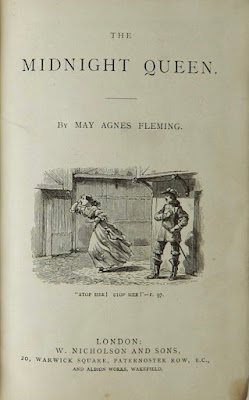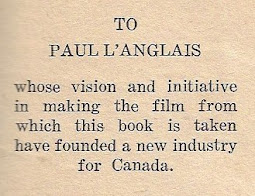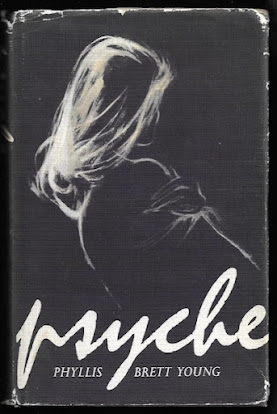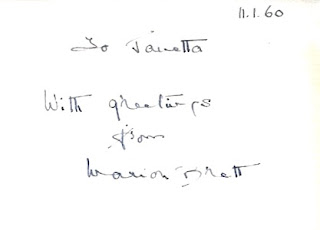The Right of Way
Gilbert Parker
New York: Grosset & Dunlap, [c.1907]
419 pages
I don't like it when a novel opens with a line of dialogue; seems so lazy. The first sentence of the The Right of Way has got to be the worst:
"Not guilty, your honor!"
And yet, I really enjoyed The Right of Way. The story begins in a crowded Montreal courtroom on a sweltering August day. The acquitted is a mystery man. Charged with the brutal murder a timber baron, he'd offered nothing more than his name. Through much of the trial, Charley Steele, the prisoner's counsel, had appeared indifferent to his client's fate, only to rise, "quietly, unnoticeably drunk," and give a most brilliant defence... which, of course, leads back to the novel's first sentence.
After returning to his office, Charley considers his victory:
"I was dull, blank, all iron and ice; the judge, the jury,
the public, even Kathleen, against me; and then that
bottle in there — and I saw things like crystal! I had
a glow in my brain, I had a tinge in my fingers; and I
had success, and” — his face clouded — “he was as
guilty as hell!”
Charley drinks a great deal. Perhaps the most interesting aspects of this interesting novel, composed as the temperance movement was growing, is its depiction of alcohol as something that can both inspire and destroy. In Charley it does both.
He marries the aforementioned Kathleen, though he does not love her. To Charley, she is "the most beautiful thing he had ever seen, but he had never regarded her save as a creation for the
perfect pleasure of the eye; he thought her the concrete
glory of sensuous purity, no more capable of sentiment
than himself."
In other words, Kathleen is a trophy wife.

It makes sense that of the sixteen illustrations that decorate this edition, only one features Kathleen. Even before the marriage, Charley had a reputation as the most brilliant lawyer in Montreal. As his practice flourishes, his marriage withers. Unbeknownst to his wife, Charley has taken to slumming it at Charlemagne's, a working man's tavern to the east of Montreal's east end. Here Parker's omniscient narrator turns discreet. Sure, Charlemagne's serves drinks, but for Charley barmaid Suzon is the greater draw. The regulars, primarily farmers and river-drivers, put up with Charley's presence until the night he decides to make a grand show of his intellect.
Badly beaten, he's thrown into the St Lawrence, only to be pulled onto a raft piloted by the very man who's acquittal features on the novel's first page. The two drift eastward toward the outskirts of the town of Chaudiere, at which the supposed murderer – “he was as guilty as hell!” – has a lonely cabin. Charley is nursed back to physical but not mental health. A head wound has left him as a child. He remembers nothing of his past and lives each day as something of an innocent, until operated on by a "great Parisian surgeon," who happens to be visiting his brother, the local curé.
Charley regains his memory, and with it his ability to read. And this is how he discovers, by way of a newspaper story, that seven months have passed, that he's been declared dead, and that his wife is now married to Captain Thomas Fairing, a former rival for Kathleen's hand.
Charley faces a dilemma:
What was there to do? Go back? Go back and
knock at Kathleen’s door, another Enoch Arden, and
say, "I have come to my own again”? Return and
tell Tom Fairing to go his way and show his face no
more? Break up this union, this marriage of love in
which these two rejoiced? Summon Kathleen out of
her illegal intercourse with the man who had been true
to her all these years?
I believe that last sentence counts as a
bloomer.
Charley chooses to stay in Chaudiere, where he finds work with the town's elderly tailor. The locals are suspicious if not hostile, particularly after the stranger lets slip that he is not a Catholic. His acceptance comes gradually, aided by his friendship with the curé and numerous good deeds. He gives to the Church, he gives to those in need, he provides free legal advice, and he saves a man's life by leaping on the back of a runaway horse (as soldiers look on). Oh, and he also translates Oberammergauer Passionsspiele to French, provides illustrations to go with the text, and designs and sews the costumes for Chaudiere's passion play.
What risks becoming a tiresome train of good deeds, is saved through the introduction of lovely Rosalie Evanturel, the postmaster's daughter. Charley is in love for the first time, but knows he cannot marry her. He also knows he cannot share his reason. And so their love is accompanied by tension and, on Rosalie's part, a measure of resentment. Though this illustration suggests otherwise, their scenes together are oddly contemporary, rising well above Victorian melodrama.
And make no mistake, The Right of Way is a Victorian novel. What's more, it was a popular Victorian novel, bringing with it coincidence and contrivance. Sleepwalking does figure. It is a fever fantasy about a man who is given a second chance at life. For it to work, the reader must believe that Charley not only acknowledges his wrongs, but cares so much for Kathleen, a woman he never loved, that he cannot return to reclaim his wealth and his social standing.
The Charley of Chaudiere is not the Charley of old. Might it be that his brain surgery wasn't wholly successful?
Trivia: The working title was Charley Bell.
Trivia II: In
a candid introduction penned for the twenty-volume
Works of Gilbert Parker, the author reveals that Charley Steele was based on someone – sadly unnamed – whom he'd known as a boy.
Trivia III: The Right of Way was adapted for the stage (1907) and twice to the silent screen (1915 and 1920). Both films are lost. In 1931, it returned to the screen as a talkie. In this clip Loretta Young (Rosalie) and Fred Kohler (Jo, the murderer) bravely attempt French Canadian accents.
Probably better as a silent film.
Object: One of the nicer Grosset & Dunlap's in my collection, this
"SPECIAL LIMITED EDITION" uses the plates and
A.I. Keller illustrations from the 1901 Harper first American edition. The novel proper is followed by twelve pages of ads for other Grosset & Dunlap titles. I purchased my copy earlier this year from a Las Vegas bookseller. Price: US$12.99.
Access: Anything but a rare book, in 1901 The Right of Way was the fourth biggest selling novel in the United States. The following year, it held the sixth spot. I'm betting it did even better in Canada
Online prices range from US$1.89 to US$185.01. As expected, there's nothing at all special about the most expensive, a Grosset & Dunlap reprint lacking jacket. A New York bookseller lists the 1931 Grosset & Dunlap photoplay edition for US$76.00. The most intriguing is a Nelson Library edition "in RARE Color DustJacket of Dead Man on Floor & Woman Kneeling with Apron, Holding Back a Large Brown Dog with Sharp Teeth," offered at US$60.00 by a California bookseller. Something similar does feature in the novel, but the scene is inconsequential (and the man involved isn't dead).
Several editions are available for download at the Internet Archive.





































